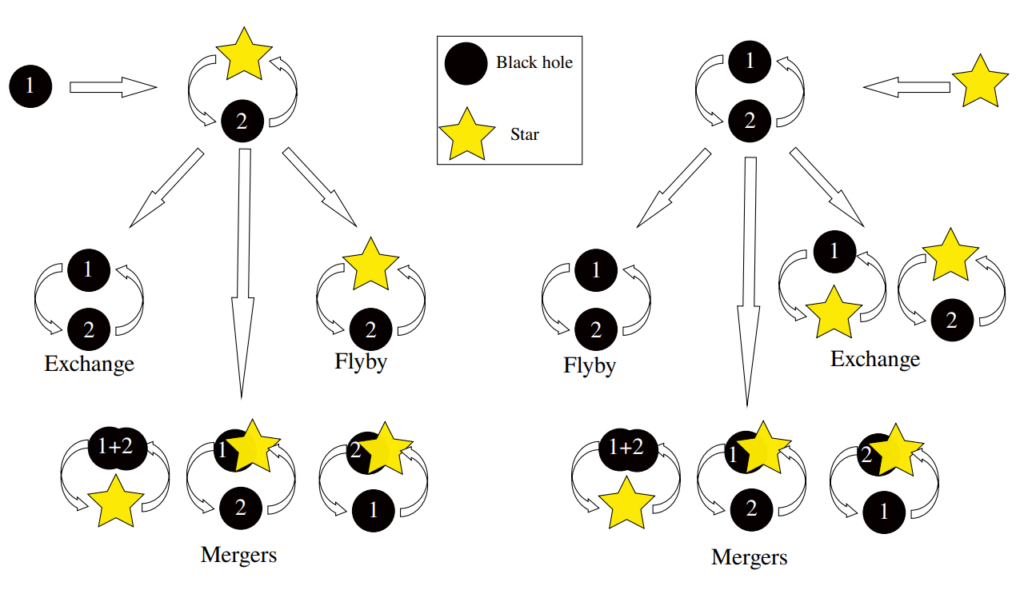Authors: Lucas Hellström, Abbas Askar, Alessandro A. Trani, Mirek Giersz, Ross P. Church and Johan Samsing
First Author’s Institution: Nicolaus Copernicus Astronomical Centre, Polish Academy of Sciences, Warsaw, Poland
Status: arXiv e-print [open access]
Within the cores of dense globular clusters, strong dynamical interactions between stellar systems (such as flybys and mergers) are common. These interactions are important because they contribute to energetic excitation of the cluster, and cause compact object binary systems to form and mergers to occur. However, analytically predicting the evolution of a closed three-mass system is in most cases impossible; this is known as the ‘Three-Body Problem’. Simulating three-body evolution has to be done numerically, advancing the system in time, step by step, while calculating the effect of all forces involved.
The authors of today’s paper specifically look at the interactions between a star and two black holes (BHs). This could be a binary black hole system interacting with a lone star, or a star+black hole system interacting with another passing black hole. They do this because, due to dynamical friction, black holes in dense stellar clusters tend to migrate inwards, and thus interactions involving multiple BHs are common, and could be a source of gravitational waves observed with LIGO and other detectors.
Rising Tides Lift All Stars
Simulations have been done to model these kinds of interactions previously. However, the authors note that there are two important additional factors that need to be considered. The first is that interactions between multiple BHs in clusters tend to dissipate energy through gravitational wave emission, causing the BHs to lose energy and possibly merge more easily than they otherwise would. In order to implement this concept into simulations, one must include ‘post-Newtonian’ (or ‘PN’) correction terms to Newton’s equations of motion.
In addition, close dynamical encounters between BHs and stars can lead to tidal dissipation or even disruption of the star. The authors hypothesize that since PN corrections should lead to an increased BH merger rate in simulations, it is possible that taking tides into account could also affect the rate of mergers in BH-BH-star interactions.
In order to investigate the effects of gravitational wave emission and tidal dissipation on the outcome of these interactions, the authors took a dataset of binary-single encounters produced with the stellar cluster Monte Carlo simulation code MOCCA, and ran them through the scattering code Tsunami. This code numerically solves the equations of motion for the three bodies and advances them forward in time. They also made sure to use a model that takes tidal dissipation and PN correction terms into account.
In Figure 1, the authors show the possible outcomes of the binary-single interaction events they simulated, both when a passing star interacts with a BH-BH binary and when a passing BH interacts with a BH-star binary. During a flyby, the passing object interacts gravitationally with the system but does not completely disrupt it. During an exchange, one of the objects in the binary is ejected, and a new binary is formed with the initially passing object. During a merger, two of the three objects will merge to form a single object. The authors’ results also show a small number of ‘ionisations’, where the incoming object causes the binary to separate, resulting in 3 single objects, but that is not shown in the figure. Long-lived stable triple-star systems can also be formed, but these are usually broken up quickly in clusters due to the high stellar density and relatively high encounter rate.

Riding the Resulting Wave
To fully test their model, the authors ran three different sets of data through the Tsunami code. The first dataset was a controlled test setup, where all stars were Sun-like stars, all BHs had a mass of 10 solar masses, and the initial setup was such that strong interactions were likely. For each of the two binary setups (BH-Star and BH-BH), the authors generated 800 interactions with 3 different seeds each.
When starting with a BH-Star binary, the authors find that exchanges are the dominant outcome of these interactions, and that including the PN terms showed no significant differences in these outcomes. However, including the effect of tides showed a significant increase in BH-Star mergers — as expected when the star’s orbital energy dissipates through tidal interactions — and a corresponding decrease in exchanges and flybys to compensate.
When starting with a BH-BH binary, the majority of the interactions were flybys and no exchanges occured, as it is unfavorable for an object with 1/10th the mass of both binary members to displace and replace one of the members. No BH-BH mergers were seen at all, but BH-Star mergers followed a similar trend as in the first setup, significantly increasing when tides were accounted for.
After testing their model with a controlled dataset, the authors input their second set of data: approximately 82000 BH-BH-Star binary-single interactions from MOCCA simulations of globular cluster evolution, with a varying range of initial parameters. This set of data was called ‘M1’.
Since strong interactions are no longer preferred, in M1 most interactions were flybys, followed by exchanges. When starting with a BH-Star binary, the number of mergers was small. When the PN terms were not included, there were no BH-BH mergers at all, but when they were included, there were several BH-BH mergers. Including tides increased the merger rate by about 40%, but once again only for BH-Star mergers. There were also a few ‘ionisations,’ which resulted in 3 single objects, and at least one triple-star system was formed; but these results were negligible compared to the other outcomes.
When starting with a BH-BH binary, the number of mergers was comparatively tiny, but more than doubled when tides were taken into account. The number of flybys, exchanges, and BH-BH vs BH-Star mergers followed the same trends as the previous dataset; PN terms increased the number BH-BH mergers, and tidal terms increased the number of BH-Star mergers, with flybys and exchanges decreasing to compensate.
For the final dataset, the authors wanted to take a closer look at the MOCCA data without so many flybys, so they filtered M1 for non-flyby, co-planar interactions and re-ran 5 seeds for each. This set of data was called ‘M2’, and it showed the same trends as the previous two datasets; mergers increased by ~70% when starting with BH-Star binaries and by ~140% when starting with BH-BH binaries.
Summary and Conclusions
In summary, through this experiment the authors confirmed that both post-Newtonian and tidal dissipation terms have an important effect on the simulation of BH-BH-Star Binary-Single interactions within dense globular clusters. Including PN terms has the direct effect of making BH-BH mergers significantly more likely, as the interacting BHs can release orbital energy through gravitational waves, causing them to fall into one another. Including tidal dissipation has a similar effect on BH-Star mergers, with tidal effects dissipating the orbital energy of the star. These results show that these effects are important considerations when simulating the evolution of clusters, as well as many-star systems, and the authors plan to study this in future publications.
Astrobite edited by Catherine Clark
Featured image credit: Pixabay




